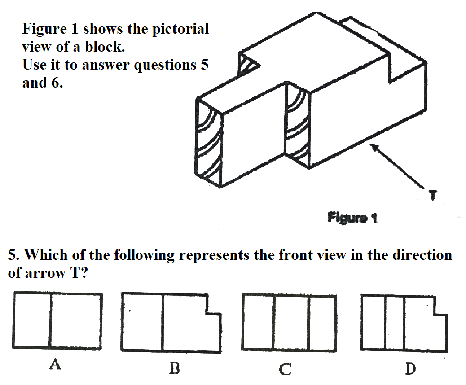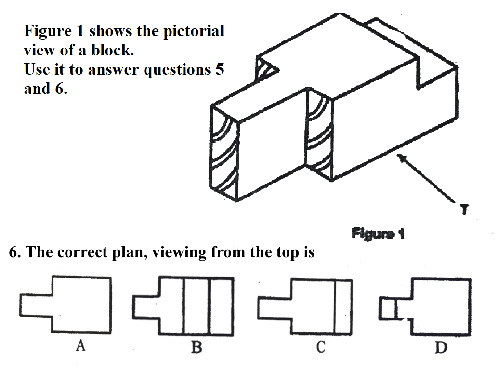1. The appropriate instrument used for drawing circles on paper is a
A. pair of dividers
B. pair of compasses
C. protractor
D. set square
A. pair of dividers
B. pair of compasses
C. protractor
D. set square
2. Which of the following methods of drawing is in two dimension?
A. Isometric
B. Oplique
C. Orthographic
D. Perspective
A. Isometric
B. Oplique
C. Orthographic
D. Perspective
3. In designing and making, the stage where useful information is gathered for solving the problem is
A. analysis
B. investigation
C. situation
D. specification
A. analysis
B. investigation
C. situation
D. specification
4. An electronic component which indicates that current is flowing in a circuit is
A. capacitor
B. diode
C. LED
D. indicator
A. capacitor
B. diode
C. LED
D. indicator
5. imageQuestion

A. A
B. B
C. C
D. D
A. A
B. B
C. C
D. D
6. imageQuestion

A. A
B. B
C. C
D. D
A. A
B. B
C. C
D. D
7. When laying a table for a customer the fork is placed
A. in front of the plate
B. at the right side of the plate
C. across the plate
D. at the left side of the plate
A. in front of the plate
B. at the right side of the plate
C. across the plate
D. at the left side of the plate
8. A French seam is the most appropriate seam for
A. children's wear
B. heavy weight fabric
C. light weight fabric
D. undergarments
A. children's wear
B. heavy weight fabric
C. light weight fabric
D. undergarments
9. In order to retain the nutrients in leafy vegetables
A. cut one hour before cooking
B. cut when ready to cook
C. cut when the water is boiling
D. cut few minutes before cooking
A. cut one hour before cooking
B. cut when ready to cook
C. cut when the water is boiling
D. cut few minutes before cooking
10. Food is preserved mainly to
A. maintain its nutrient
B. make it last longer
C. make it palatable
D. protect micro-organisms in food
A. maintain its nutrient
B. make it last longer
C. make it palatable
D. protect micro-organisms in food
11. On the 6-point colour wheel, blue is next to
A. Green
B. Orange
C. Yellow
D. Red
A. Green
B. Orange
C. Yellow
D. Red
12. Identify the pair that are principles of design.
A. Variety and rhythm.
B. Balance and colour.
C. Repetition and dots.
D. Contrast and shape.
A. Variety and rhythm.
B. Balance and colour.
C. Repetition and dots.
D. Contrast and shape.
13. The colour violet symbolizes
A. Wealth.
B. Peace.
C. Aggression.
D. Royalty.
A. Wealth.
B. Peace.
C. Aggression.
D. Royalty.
14. The inscription BB on a pencil indicates that it
A. is hard.
B. is soft.
C. breaks easily.
D. sharpen well.
A. is hard.
B. is soft.
C. breaks easily.
D. sharpen well.
15. Which of the following depends on the principles of perspective in design?
A. Balance
B. Foreshortening
C. Repetition
D. Rhythm
A. Balance
B. Foreshortening
C. Repetition
D. Rhythm
16. An important factor to consider when selecting an opening for a garment is
A. Style of garment.
B. The type of fabric.
C. Length of fastening.
D. Colour of fastening.
A. Style of garment.
B. The type of fabric.
C. Length of fastening.
D. Colour of fastening.
17. Covering puddings with grease proof paper when steaming is to
A. Make it cook quickly
B. Prevent it from sinking
C. Prevent water from entering
D. Make it rise quickly
A. Make it cook quickly
B. Prevent it from sinking
C. Prevent water from entering
D. Make it rise quickly
18. A characteristic of animal fibre is that they
A. Melt at high temperature.
B. Have low absorption power.
C. Have high absorption power.
D. Are good conductors of heat.
A. Melt at high temperature.
B. Have low absorption power.
C. Have high absorption power.
D. Are good conductors of heat.
19. An appliqué patch is most often used on
A. Girls uniform.
B. Men’s shirt
C. Pair of trousers.
D. Children’s cotton blouse
A. Girls uniform.
B. Men’s shirt
C. Pair of trousers.
D. Children’s cotton blouse
20. Buttons and loops are best used on the back neck edge silt of
A. School uniforms for girls.
B. Nurses uniform.
C. Baby's dresses.
D. Blouse for the aged.
A. School uniforms for girls.
B. Nurses uniform.
C. Baby's dresses.
D. Blouse for the aged.
21. Dish cloths are used in the kitchen for
A. Wiping working tables and boards.
B. Wiping glassware and cutlery.
C. Removing dishes from oven.
D. Removing dishes from oven.
A. Wiping working tables and boards.
B. Wiping glassware and cutlery.
C. Removing dishes from oven.
D. Removing dishes from oven.
22. Select the dry methods of cooking from the following
A. Braising and baking.
B. Stewing and roasting.
C. Braising and stewing.
D. Roasting and baking.
A. Braising and baking.
B. Stewing and roasting.
C. Braising and stewing.
D. Roasting and baking.
23. To transfer pattern markings from paper pattern onto fabric, use
A. Tailor's tacks
B. Basting
C. Tacking
D. Even tacking
A. Tailor's tacks
B. Basting
C. Tacking
D. Even tacking
24. A suitable temporary stitch used to hold down interfacing of a round collar is
A. Even tacking
B. Long and short tacking
C. Diagonal tacking
D. Tailors tacking
A. Even tacking
B. Long and short tacking
C. Diagonal tacking
D. Tailors tacking
25. Which of the following vitamins can easily be destroyed by heat?
A. Vitamin A
B. Vitamin B
C. Vitamin D
D. Vitamin K
A. Vitamin A
B. Vitamin B
C. Vitamin D
D. Vitamin K
26. Table linen include
A. Cloths and napkins.
B. Crockery and table runners.
C. Table cloth and cutlery.
D. Table mats and glassware.
A. Cloths and napkins.
B. Crockery and table runners.
C. Table cloth and cutlery.
D. Table mats and glassware.
27. A change in colour of a peeled banana left in the open is due to
A. Yeast activities.
B. Presence of fungi.
C. Fermentation.
D. Oxidation.
A. Yeast activities.
B. Presence of fungi.
C. Fermentation.
D. Oxidation.
28. When frying meat, heat is transferred by means of
A. Radiation.
B. Conduction and convection.
C. Radiation and convection.
D. Conduction.
A. Radiation.
B. Conduction and convection.
C. Radiation and convection.
D. Conduction.
29. Which of the following is a white fish?
A. Mackerel
B. Cod
C. Herring
D. Tilapia
A. Mackerel
B. Cod
C. Herring
D. Tilapia
30. A meal eaten between breakfast and lunch is
A. High tea.
B. Snack.
C. Supper.
D. Confectioner.
A. High tea.
B. Snack.
C. Supper.
D. Confectioner.






0 Comments